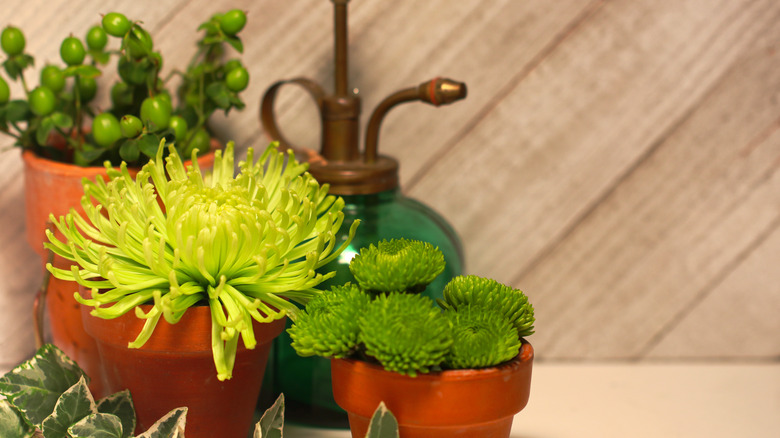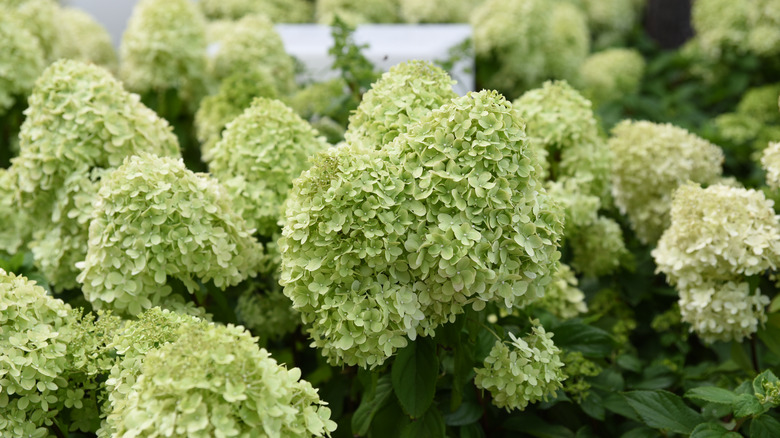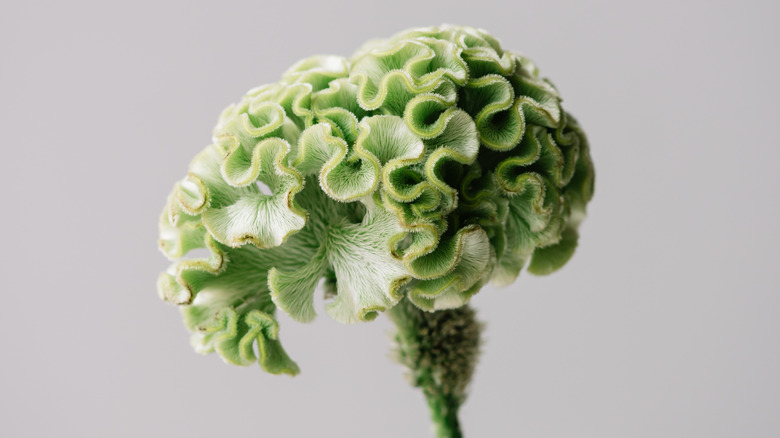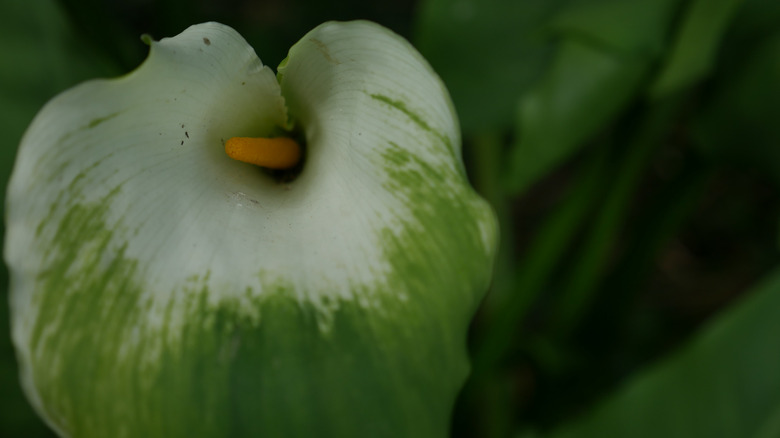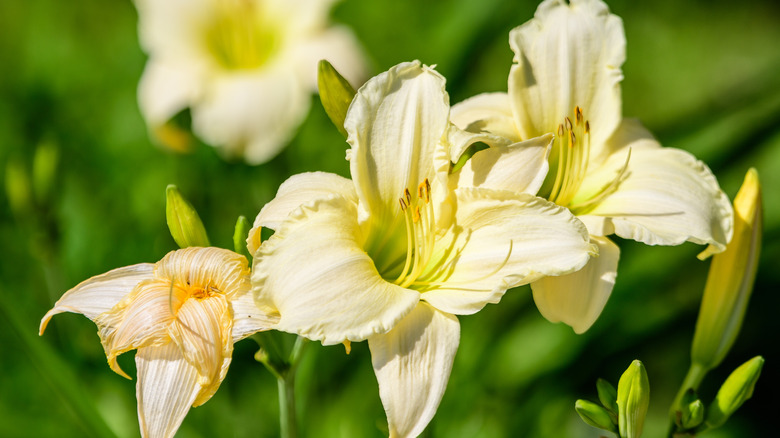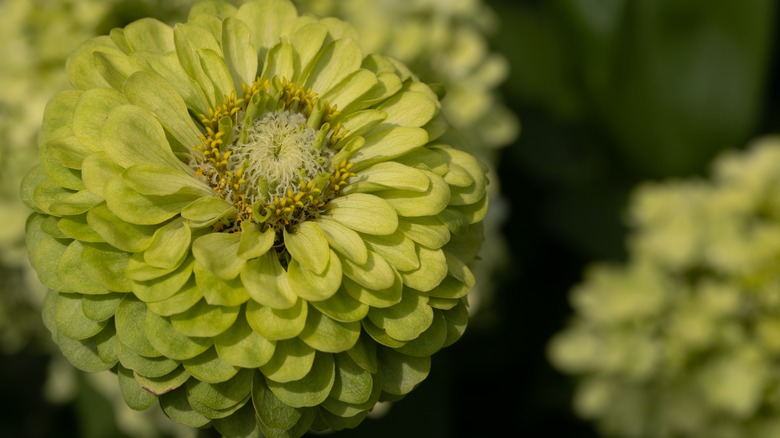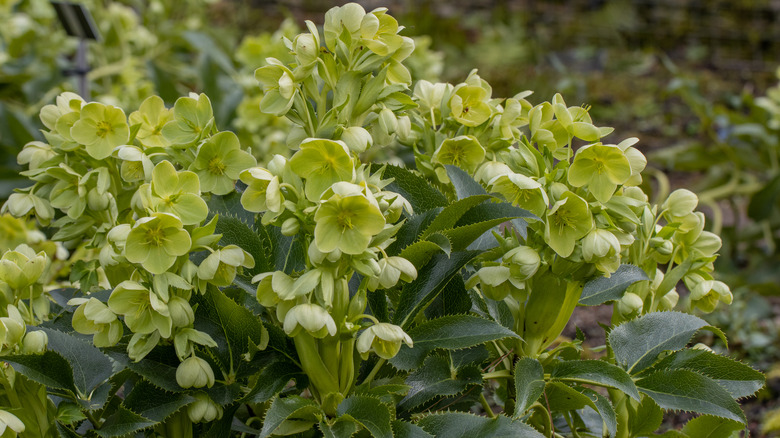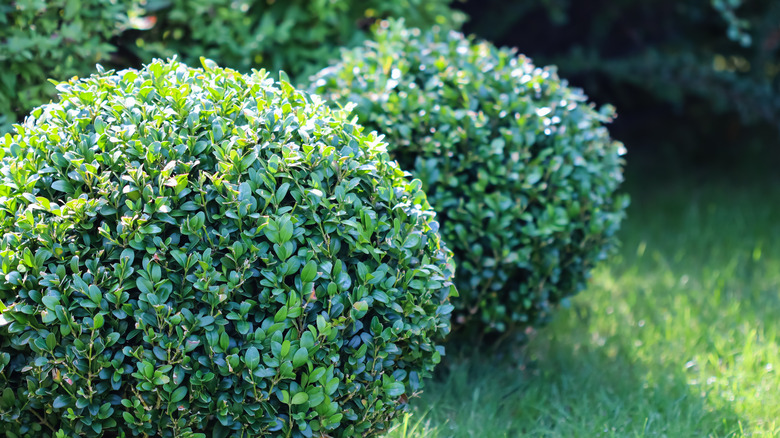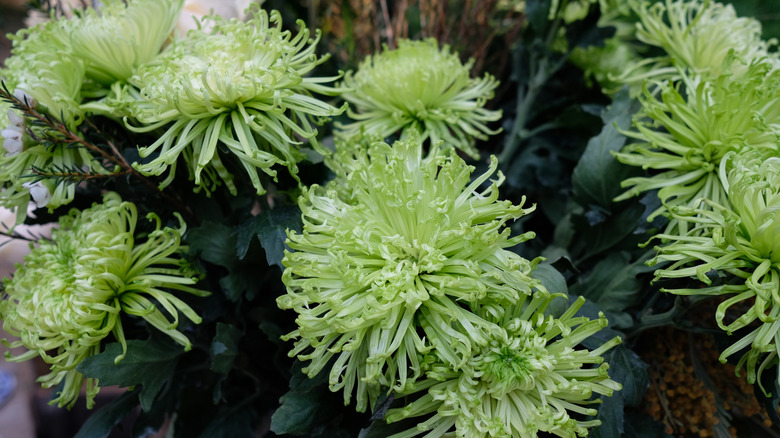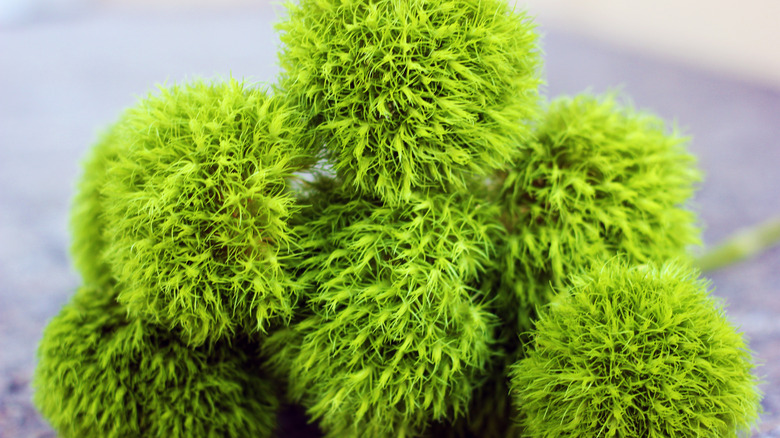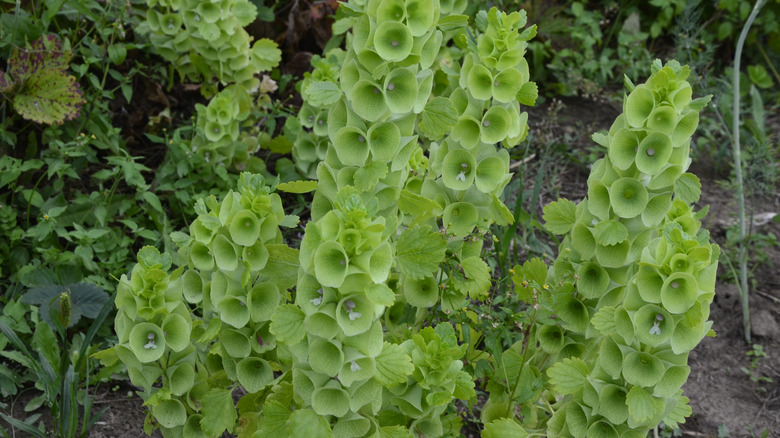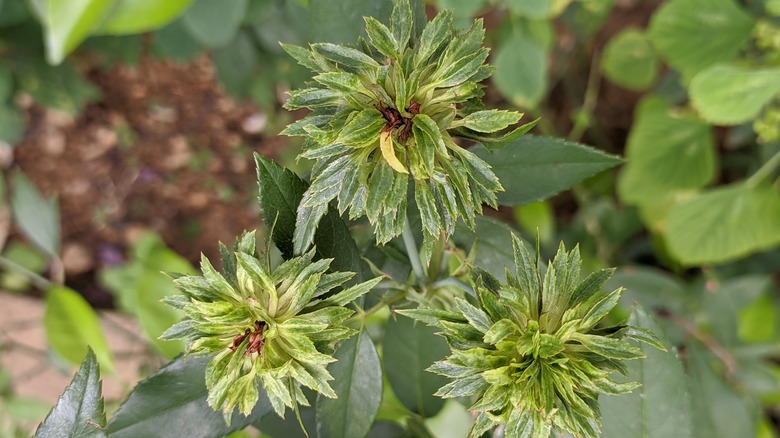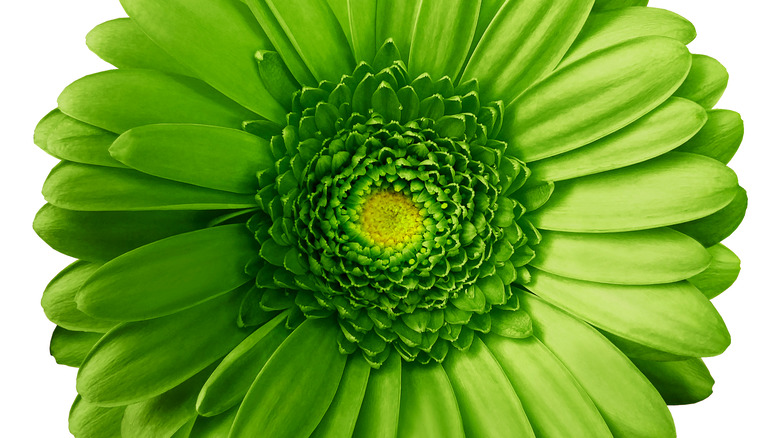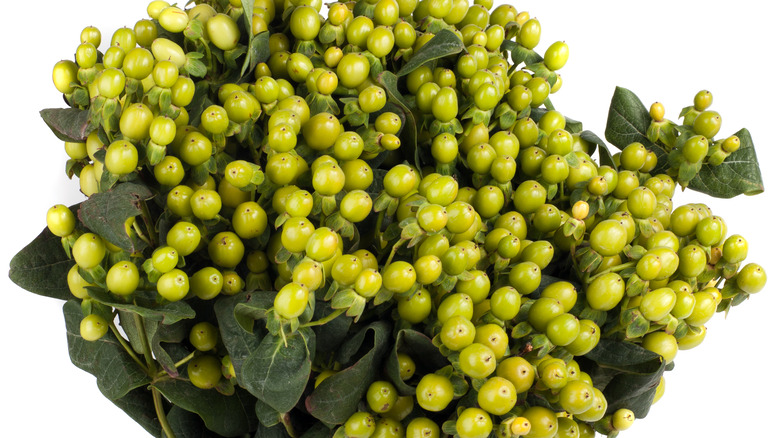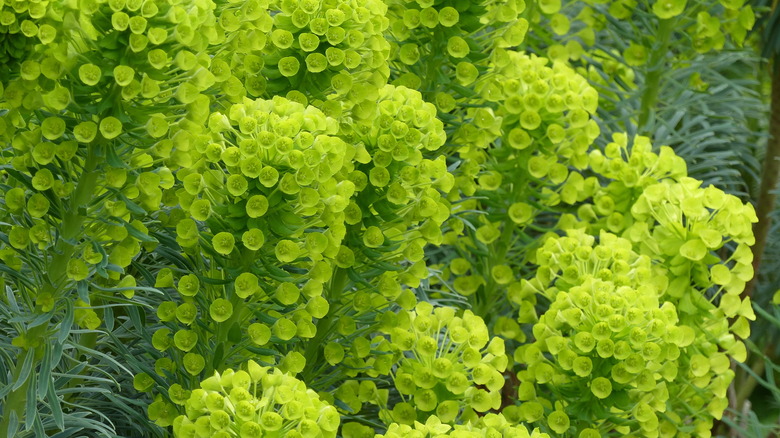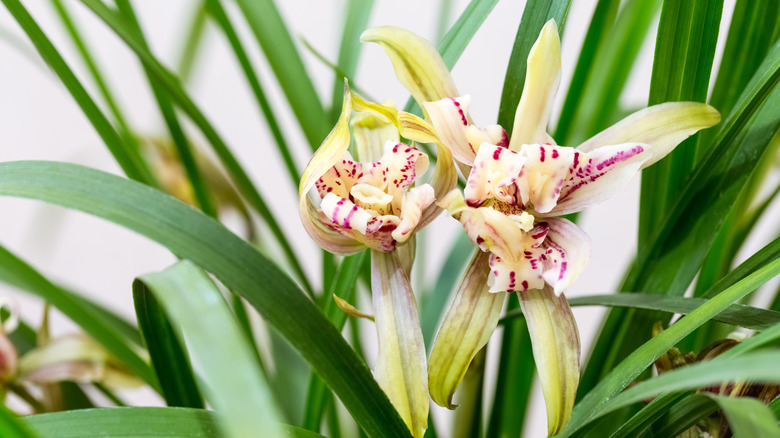15 Stunning Green Flowers You Should Grow In Your Garden
When you imagine a beautiful flower garden, which colors come to mind? For many, it might be red roses, white daisies, yellow daffodils, or purple lilacs that are at the top of their list. One flower color that is looked over, again and again, is green. There is already plenty of green naturally occurring in the garden; Surly grass, plant stems, and leaves bring forth all the greens you need. Or do they?
Green flowers such as gerberas, bells of Ireland, and Mediterranean spurge can add stunning visuals and attractive textures to your garden. They are also thought to bring luck, optimism, good fortune, and youth to gardeners, according to Country Living. Though green flowers are often said to be difficult to care for, many annuals and perennials are surprisingly low-maintenance. Before planting any of these flowers, keep in mind your city's climate and your flower's growing conditions. Not much is worse than buying lots of beautiful green flowers only to see them die after a few weeks due to the wrong environment.
1. Limelight hydrangea
This green hydrangea (hydrangea paniculata), referred to as limelight, is coveted by many gardeners. Not always the first choice for beginners, the paniculata species is, in fact, very easy to grow, according to Proven Winners. Throughout its bloom season, the flowers can turn from green to shades of pink and white.
If you are looking for a fun, color-changing flower to bring new life to your garden, this 6- by 6-foot shrub may do the trick. Hydrangeas grow in USDA hardiness zones 3 through 9. Remember, before you plant, that they enjoy partial sunlight and well-draining soil.
2. Cockscombs
Green cockscomb (celosia cristata), also known as spring green is a flower that enjoys hot, full sun conditions, says The Gardener's Workshop. At maturity, the cockscomb plant is 12 inches tall and wide. It produces unique, velvety flowers with twisting petals that accent its dark green foliage.
Other than green, you can also find gorgeous cockscomb flowers in white, red, yellow, pink, and orange. It grows best in moist, loamy soil in USDA hardiness zones 9 through 12.
3. Green goddess calla lily
Calla lilies (zantedeschia aethiopica) of the green goddess variety are a rare sight. Their siblings, which feature white trumpet-shaped flowers, are more often used in bouquets, but the green versions are less well-known. Calla Lilies can grow up to 36 inches tall and bloom from late spring to midsummer, reports Gardenia.
These flowers do best in USDA hardiness zones 8 through 10 and should be planted in moisture-retentive soil in partial sun. Many gardeners like to use their Calla lilies as border plants or as edging around ponds.
4. Daylily
Oaks lily, mean green, Forsyth flaming snow, and Tutankhamun are just some of the hemerocallis species' varieties that feature beautiful lime green color on their petals, as described by HGTV. The blooms on daylilies can vary from species to species, but most will measure about 4 to 9 inches across.
All daylilies are low-maintenance plants that grow in USDA hardiness zones 3 through 10. They can survive drought, poor soil, and shade. Though, you should plant them in fertile, well-draining soil and water them about once per week, says Almanac.
5. Green envy zinnia
Green envy zinnias (zinnia elegans) are highlighted by their flowers' bushy form and chartreuse color. When planted sometime between April and June, you can expect the vivid flowers to bloom during the midsummer to fall season, according to Renee's Garden.
You can grow Zinnias almost anywhere as annuals, but they prefer living where temperatures consistently stay about 50 degrees Fahrenheit, such as in growing zones 9 through 11. When you are ready to plant your zinnias, be sure to pick a location with ordinary garden soil and full sun.
6. Hellebores
Green hellebore (helleborus viridis) is a perennial herbaceous flower that can grow up to 16 inches tall, notes Nature & Garden. The green-petalled plant blooms from February to June. In nature, hellebore plants grow in forested areas with rocky soil where they receive partial sun and plenty of water.
They need the slightly colder climates of USDA hardiness zones 3 through 9 to survive. Other green hellebore species include helleborus argutifolius, helleborus sternii, helleborus foetidus, and helleborus odorus. Although slightly different from one another, they all share the same growing conditions.
7. Boxwood shrubs
Although boxwood shrubs (Buxus spp.) aren't flowers, they can be a great green addition to your garden, and are commonly used in landscaping, explains Proven Winners. They stay beautiful year-round with proper care, and they can tolerate most types of soil and climates.
Their preferred hardiness zone is most often listed as 5 through 9, but some cultivars can withstand colder temperatures. Keep in mind, that boxwood shrubs can become quite large, sometimes reaching up to 20 feet tall and 8 feet wide. Provide your shrub with a wind-sheltered location that receives partial sun.
8. Chrysanthemums
Chrysanthemums or mums are one of the most common green flowers that you can find. More than 100 cultivars of the flower are known today. Some green Chrysanthemum varieties include key lime, green mist, star mist, and green star, as described by Balcony Garden Web.
Mums are hardy flowers that usually thrive in USDA zones 5 through 9. They are a staple in fall gardens (via Gilmour), as they bloom throughout the season. It is recommended to plant mums in well-draining soil where they will receive at least 6 hours of sunlight per day.
9. Green trick carnations
Green trick carnations (dianthus barbatus) are known as novelty flowers, according to Nurseries Online. Developed in Holland, the lime green moss-like flower is somewhat high-maintenance.
To grow green tricks, you must provide a protected location that uses humus-rich soil and plenty of sunlight. The flowers measure about 3 to 4 inches wide and bloom from June to October. It is a hardy perennial that can grow in USDA hardiness zones 3 through 9, notes the North Carolina Extension Gardener Plant Toolbox.
10. Bells of Ireland
One of the most unique green flowers you can plant in your garden is the Bells of Ireland (molucella laevis). Despite its name, the plant is native to Turkey, explains Morflora. It is characterized by green stems, bell-shaped leaves, and tiny green flowers.
Usually grown in the garden, this flower can become 3 feet tall. It enjoys almost any soil as long as it is well-draining. What's really important to the Bells of Ireland is a location with full sunlight and high humidity. They are hardy to USDA zones 9 through 11.
11. Roses
Amateur and expert gardeners alike are familiar with caring for roses. Yet, many have never encountered a green rose (Rosa chinensis viridiflora). The flower, which is made up almost exclusively of layers of sepals, cannot reproduce according to Mountain Valley Growers, and can only be propagated by graftings and cuttings.
The green rose can survive in growing zones 5 through 11 as a perennial. They need full sun, well-draining soil, and fertilization in the spring. Their 4-inch-wide leafy blooms stay open during the spring and summer atop stems that can reach 4 feet tall.
12. Gerbera
Gerbera flowers (gerbera jamesonii) can be found in several different colors including green, white, orange, and red, notes IFAS Extension University of Florida. The flower, which measures 2 to 5 inches across, blooms in the summer and fall.
They are best grown in warmer temperatures such as USDA hardiness zones 8, 9, and 10, but they can withstand chills as low as 30 degrees Fahrenheit. If you plan to grow green gerberas make sure that you plant them in well-draining, sandy soil, and ensure that they receive plenty of sun during the morning and some shade in the afternoon.
13. Hypericum berries
Hypericum (hypericum androsaemum) is a variety of St. John's Wort that is coveted for its berries which can appear green, pink, brown, or red. Though they are most often found in wedding bouquets, they can also be grown in the garden, explains Garden Guides.
You can grow green hypericum berries in growing zones 5 through 8 in well-draining soil. They enjoy full sun to partial shade and low humidity. If you plan to grow hypericum, be sure to buy hypericum androsaemum specifically. There are several varieties of St. John's Wort, but many aren't suitable for flower arrangements.
14. Mediterranean Spurge
Mediterranean spurge (euphorbia characias) is a low-maintenance perennial normally used for ground cover. Native to Turkey, Albania, and Southern Europe, vis North Carolina Extension Gardener Plant Toolbox., the plant loves the hot and dry climates in USDA zones 7 through 10.
Mediterranean spurge is characterized by an upright growth habit, petal-less green cyathia flowers, and narrow leaves. The plant can grow in soil that is rocky, dry, and shallow. You may see it growing in small spaces or even on rock walls, as all it really needs to grow is full sun and a little water.
15. Cymbidium orchids
There are several different varieties of cymbidium orchids that can be found in pink, green, yellow, or white. Two common green cymbidium orchids are the cymbidium kanran and the cymbidium ensifolium, explains Brilliant Orchids. Both orchids feature spindly petals, need plenty of sunlight, and enjoy high humidity.
As a general rule, you can grow these orchids anywhere that has temperatures above 40 degrees Fahrenheit, or USDA zones 9 through 12. For best results, they should be planted in water-retaining soil and in a place that receives full sun, however, be sure to watch for sunburn.
